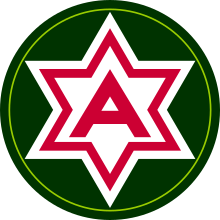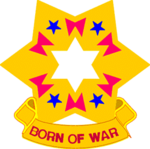
Jonathan Mayhew Wainwright IV was an American army general and the Commander of Allied forces in the Philippines at the time Japan surrendered to the United States, during World War II.
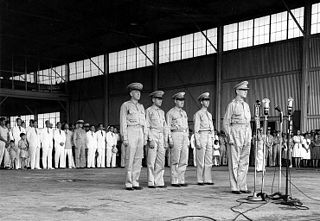
United States Army Forces in the Far East (USAFFE) was a military formation of the United States Army active from 1941 to 1946. The new command's headquarters was created on 26 July 1941, at No. 1, Calle Victoria, Manila, Luzon, the Philippines, with General Douglas MacArthur as commander. The Chief of Staff was Brigadier General Richard K. Sutherland and the Deputy Chief of Staff was Lieutenant Colonel Richard J. Marshall. The core of this command was drawn from the Office of the Military Advisor to the Commonwealth Government of the Philippines.
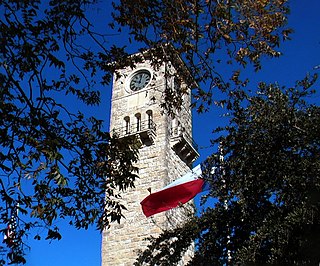
Fort Sam Houston is a U.S. Army post in San Antonio, Texas. Known colloquially as "Fort Sam," it is named for the U.S. Senator from Texas, U.S. Representative from Tennessee, Tennessee and Texas governor, and first president of the Republic of Texas, Sam Houston.
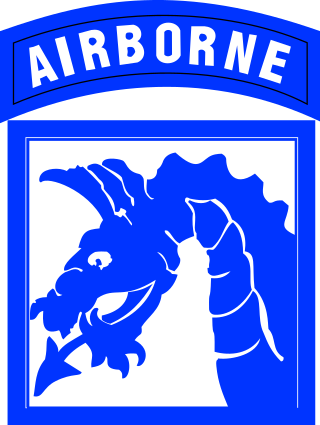
The XVIII Airborne Corps is a corps of the United States Army that has been in existence since 1942 and saw extensive service during World War II. The corps is designed for rapid deployment anywhere in the world and is referred to as "America's Contingency Corps." Its headquarters are at Fort Liberty, North Carolina.

First Army is the oldest and longest-established field army of the United States Army. It served as a theater army, having seen service in both World War I and World War II, and supplied the US army with soldiers and equipment during the Korean War and the Vietnam War under some of the most famous and distinguished officers of the U.S. Army. It now serves as a mobilization, readiness and training command.

The 77th Sustainment Brigade is a unit of the United States Army that inherited the lineage of the 77th Infantry Division, which served in World War I and World War II. Its headquarters has been at Fort Dix, New Jersey, since its predecessor command, the 77th Regional Readiness Command, was disestablished in 2008 from Fort Totten in Bayside, Queens, New York. Soldiers from the 77th have served in most major conflict and contingency operations since World War II.

The 96th Sustainment Brigade, is a combat service support formation of the United States Army Reserve. It traces its history to the 96th Infantry Division which served in the Asia-Pacific theater during World War II. Effective 17 September 2008, the unit became the 96th Sustainment Brigade, with its headquarters located at Fort Douglas, Salt Lake City, Utah.

The 6th Ranger Battalion was a United States Army Ranger Battalion which saw action in the Pacific during World War II. The battalion is best known for its role in the Raid at Cabanatuan in the Philippines in January 1945.

Brooke Army Medical Center (BAMC) is the United States Army's premier medical institution. Located on Fort Sam Houston, BAMC, a 425-bed Academic Medical Center, is the Department of Defense's largest facility and only Level 1 Trauma Center. BAMC is also home to the Center for the Intrepid, an outpatient rehabilitation facility. The center is composed of ten separate organizations, including community medical clinics, centered around the Army's largest in-patient hospital. BAMC is staffed by more than 8,000 Soldiers, Airmen, Sailors, Civilians, and Contractors providing care to wounded Service Members and the San Antonio Community at-large.

The 1st Infantry Regiment is a regiment of the United States Army that draws its lineage from a line of post American Revolutionary War units and is credited with thirty-nine campaign streamers. The 1st Battalion, 1st Infantry is assigned as support to the United States Military Academy at West Point, New York and to furnish the enlisted garrison for the academy and the Stewart Army Subpost. 2nd Battalion, 1st Infantry Regiment is an infantry component serving with the 2nd Stryker Brigade, 2nd Infantry Division at Joint Base Lewis–McChord, Washington.
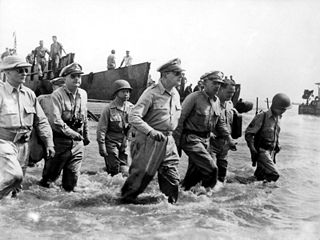
The Philippines campaign, Battle of the Philippines, Second Philippines campaign, or the Liberation of the Philippines, codenamed Operation Musketeer I, II, and III, was the American, Mexican, Australian and Filipino campaign to defeat and expel the Imperial Japanese forces occupying the Philippines during World War II.

Leon L. Van Autreve was a United States Army soldier who served as the fourth Sergeant Major of the Army. He was sworn in on July 1, 1973, and served until June 1975.

Fourth United States Army was a field army of the United States Army between 1932 and 1991.
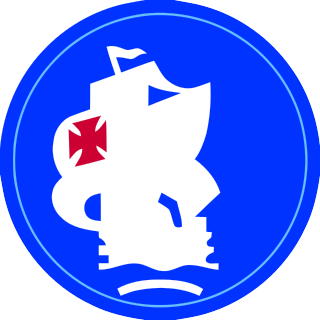
United States Army South is an Army service component command of United States Southern Command whose area of responsibility includes 31 countries and 15 areas of special sovereignty in Central and South America and the Caribbean. It is headquartered at Fort Sam Houston, Texas.

The United States Army North (ARNORTH) is a formation of the United States Army. An Army Service Component Command (ASCC) subordinate to United States Northern Command (NORTHCOM), ARNORTH is the joint force land component of NORTHCOM. ARNORTH is responsible for homeland defense and defense support of civil authorities. ARNORTH is headquartered at Fort Sam Houston, Texas. Redesignated ARNORTH in 2004, it was first activated in early January 1943 as the United States Fifth Army, under the command of Lieutenant General Mark W. Clark.

The 19th Infantry Regiment is a United States Army infantry regiment which is assigned to the US Army Training and Doctrine Command, with the assignment of conducting Basic and Advanced Infantry Training.
The 34th Infantry Regiment is a Regular Army infantry regiment of the United States Army. It saw combat in World War I, in the Pacific Theater of Operations in World War II, and was the first full American regiment deployed in combat in the Korean War. The 1st and 3rd Battalions of the 34th are now basic training formations attached to the 165th Infantry Brigade at Fort Jackson, South Carolina.
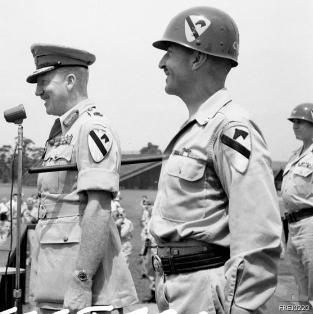
Major General William Curtis Chase was an American soldier and general in the first half of the 20th century. He is best known for his service in the South West Pacific Area during World War II and in the Occupation of Japan.

The 1st Filipino Infantry Regiment was a segregated United States Army infantry regiment made up of Filipino Americans from the continental United States and a few veterans of the Battle of the Philippines that saw combat during World War II. It was formed and activated at Camp San Luis Obispo, California, under the auspices of the California National Guard. Originally created as a battalion, it was declared a regiment on 13 July 1942. Deployed initially to New Guinea in 1944, it became a source of manpower for special forces and units that would serve in occupied territories. In 1945, it deployed to the Philippines, where it first saw combat as a unit. After major combat operations, it remained in the Philippines until it returned to California and was deactivated in 1946 at Camp Stoneman.

The Seventh Army was a United States army created during World War II that evolved into the United States Army Europe (USAREUR) during the 1950s and 1960s. It served in North Africa and Italy in the Mediterranean Theater of Operations and France and Germany in the European Theater between 1942 and 1945.
